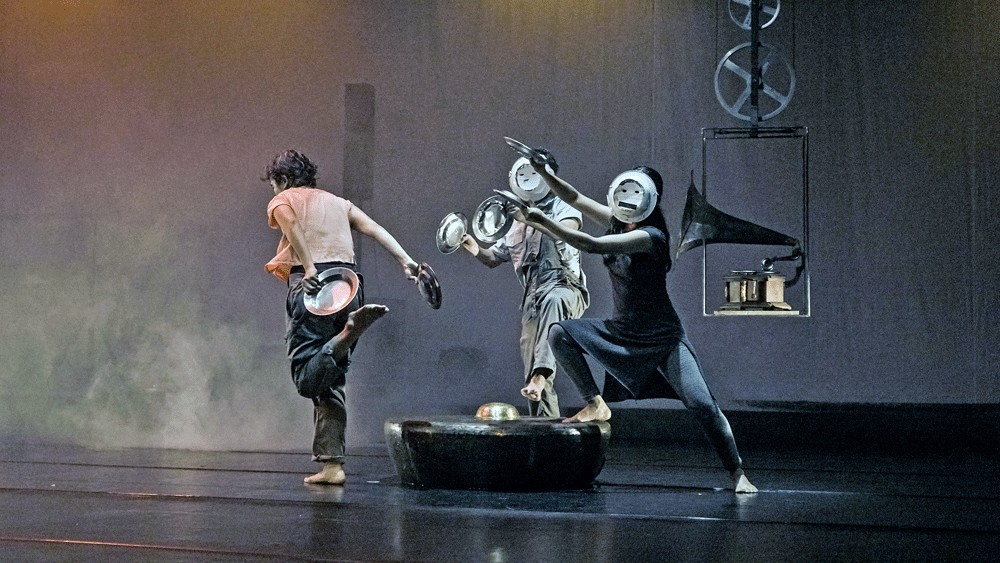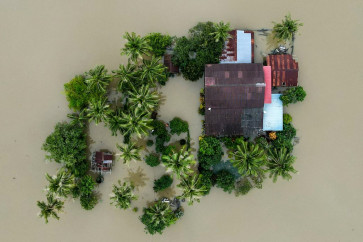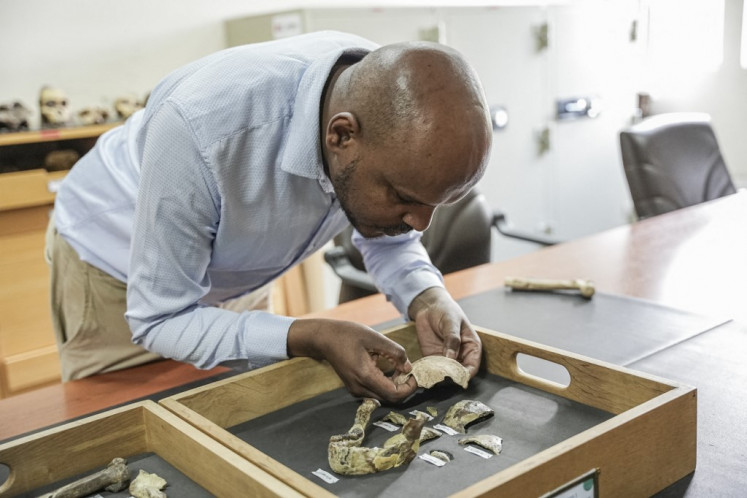Popular Reads
Top Results
Can't find what you're looking for?
View all search resultsPopular Reads
Top Results
Can't find what you're looking for?
View all search results'Gong Ex Machina': A harmonious symphony of sound and theater
Change text size
Gift Premium Articles
to Anyone
Y
ogyakartan artist collective Teater Garasi’s Gong Ex Machina puts audience members’ sense of hearing on overdrive as sound itself becomes the star of the show.
Three-D ( 3D ) soundscapes burst out of every corner of the theater hall during the Gong Ex Machina presentation, creating an experience that provokes every sense in each audience member’s body.
The performance, staged at the Gedung Kesenian Jakarta playhouse in Central Jakarta on Thursday and Friday, was the brainchild of renowned Japanese sound designer Yasuhiro Morinaga and prominent theater artist Yudi Ahmad Tajudin of Teater Garasi artist collective from Yogyakarta.
The show is derived from the ancient Greek theater term deus ex machina (god from the machine), which describes the sudden introduction of a deity into a story to resolve a complicated plotline.
Also part of Gong Ex Machina’s divine inspiration is Morinaga’s earlier research on Southeast Asian cultures’ use of gongs, in which his findings showed that the produced sound and the instrument itself serves as a medium of communication between humans and supernatural entities.
It is precisely this feeling of ethereal divinity that Morinaga and Yudi sought to bring to the audience, with the first few minutes of the 60-minute show filled with natural yet minimalistic sound and light smoke obscuring most of the stage, creating an eerie yet serene and contemplative atmosphere.
The sound of a gong echoes through the room and a man enters the stage to sit in the lone chair. He is revealed to be Morinaga, accompanied by an audio recording of himself reflecting on his research and journey across various cultures.
 Sound experience: The sound itself is the main star of the sonic theater performance, as various sounds echo and coalesce into a singular mood that evokes different feelings for different scenes.
Sound experience: The sound itself is the main star of the sonic theater performance, as various sounds echo and coalesce into a singular mood that evokes different feelings for different scenes.
Another gong is sounded several times and a man’s voice booms out, narrating the genesis of the universe, which started from sound.
“A beginning, from sound. A bang, creates. A vibration, a long hum that creates waves; creates space and with it, time. And then nebulas coagulate and solidify into planets; countless planets and trillions of galaxies. A little dot among them all, so small and insignificant: Earth, us. A hum that creates in seven days.”
This narration is repeated several times, each with increasing echoes that reverberate in the room thanks to the clever placement of speakers at different levels in the sloped audience area.
As the narration continues to unfold divine analogies regarding creation, performers holding gongs enter the stage through the middle path bisecting the seating area, creating a sense of depth and immersion one would not normally expect from a theater performance.
Still, Gong Ex Machina is billed as an immersive 3D experience and this shows that the experience is not limited to soundscapes only.
The sound itself is the main star of the sonic theater performance, as various sounds echo and coalesce into a singular mood that evokes different feelings for different scenes, interspersed with gong sounds that make the experience much more transcendental.
At a certain point, three gramophones are lowered into the stage by cranes. The center gramophone then plays a speech by inventor Thomas Alva Edison entitled “Electricity and Progress”, which was recorded in 1908.
The actors on stage interact with it with various gestures as they make sounds over the contraption, apparently signifying the cultural progress brought about by the industrial revolution of the 17th century.
The speech continues onwards, beginning to feel more distant and echoing as the sound of bells tolling interspersed with periodical gongs give way to revving engines, sirens and humming airplanes that sound vaguely wartime-like. The performers also move much more erratically, reflecting the feeling of chaos the sound evokes.
A respite from the turmoil is present in the next scene, when the sounds of gongs are much more melodious. A sense of tradition is also present through an excerpt of a speech by Surakarta noble Wuryaningrat.
Jazz singer Mian Tiara also shone through her vocals, which she put to good use in a number of scenes, most notably in one where she appears to sing in an abstract, ancient language that conjures images of mystic rituals, accompanied by performers who beat their instruments rhythmically.
Nearing the show’s end, the mood once again becomes transcendental, as if asking the audience to reflect on their spirituality. This is compounded with the closing narration, which seems to address viewers gently yet directly: “Do you hear me? Really, really hear me? Do you understand me? Really, really understand me?”
While each individual would certainly derive different experiences out of the show, Japanese sound engineer Tetsushi Hirai, who was responsible for the technical aspects of the audio production, said he wanted the whole audience to have one common experience as the members digest the performance: immersiveness.
“I think immersiveness is like a universe located inside your brain. I wanted the experience to be as if you are wearing headphones, surrounded by both natural and artificial sounds,” Hirai said through an interpreter, adding that the soundtrack contains approximately 600 different sounds in total.
Hirai likens the three speaker positions in the audience area as different dimensions: the bottom layer as the Earth, the middle layer as the ear and the top layer as space.
“With this [setup], I created a sound space of sorts, so everyone is able to immerse themselves while also using their imagination and previous experiences.”











